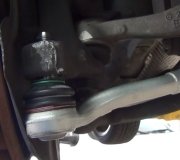I was going to mention the steering gear mounting bolts, but if those were loose or the rubber inserts were worn, that will not cause a pull or drift. It will cause the tires to follow the bumps and ruts in the road, and you would have to counteract that by turning the steering wheel. You'd feel thumping in the steering wheel too.
Correct suspension ride height also affects tire wear and handling even when the alignment appears to be perfect. Sagged front coil springs have less detrimental affect on the handling of your van compared to other car and truck models, but if rear helper springs raised the back of the van significantly, that will lower the front caster readings. Caster is mainly involved with directional stability and the steering wheel self-returning to center when you let go of it after going around a corner. As the rear of the van goes up, caster goes down, and as caster goes down, you'll need to be making more small steering corrections at highway speed. The lower caster gets, the more tiring the vehicle is to drive since you can't just hold the steering wheel with one finger and buzz down the road. As I mentioned earlier, caster isn't adjustable on your van, and there really is no need to adjust it. 3.0 degrees is common and typical, so what you listed is fine, and if the numbers printed out in green, they are in specs.
A worn wheel bearing would have presented other symptoms before it got to this point. You would have heard a loud buzzing noise for many months before any slop or play developed. The exception would be if the large axle nut was loosened. That is what holds the bearing together. Tightening the nut would take the play out of the bearing, but it would always be noisy after that.
Anything else in the steering system should include clunking or thumping felt in the steering wheel. That includes the small universal joints in the steering shaft, and the spool valve inside the steering gear.
We always think about something coming apart in the rack and pinion assembly, but that too would be met with binding and / or clunking that you would feel. In ten years as the suspension and alignment specialist at my local Chrysler dealership, the only rack and pinion steering gear coming apart I ever came across was in my mother's '95 Grand Caravan. That one was bad enough the van couldn't be driven. Turns out someone else had it apart years earlier and didn't reassemble it correctly.
Most times we now install "quick struts" which include new coil springs and upper mounting plates. Parts cost more, but labor time is greatly reduced and there are no safety concerns with escaping compressed springs. In the past it was customary to take the spring and upper plate off and reuse them when replacing the struts. If that is what was done, the center hole in the upper plate could be worn larger and could have been overlooked. That could allow the strut's shaft to slide left and right when you hit bumps in the road. You may not feel that when it occurs, but it will change "camber". Camber is the inward or outward tilt of the wheel as viewed from in front of the van. Most importantly, a tire will want to pull in the direction it is leaning. Besides adjusting camber to specs to reduce tire wear, it is important that both sides be set nearly the same so their pulls counteract each other. I always had my alignment computer set to read two digits after the decimal point. That provides more accuracy but it takes longer to set each wheel perfectly. The issue still remains here that something is changing, not simply set wrong. The nuts on the tops of the strut shafts sit in a fairly tight pocket, so on your model, a worn-out hole is not a real good suspect. What is a better suspect is the strut towers are rusted from road salt. Those towers are the sheet metal the upper mounting plates are bolted to. To check for this, tug on the top of the front tires while the alignment equipment is set up. If the camber reading changes significantly, it has to be due to something that holds that wheel in alignment, and anything that is changing will cause intermittent pulling.
Tuesday, February 5th, 2019 AT 9:02 PM


